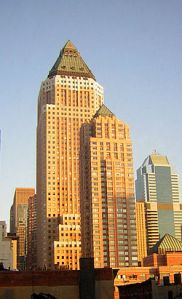The Worldwide Plaza is a collection of office and residential buildings occupying a city block in West Midtown. First constructed in 1989, the complex has gone through a multitude of owners in its 24-year history, inspiring one reporter to write, “[I]ts long list of suitors has made it the Elizabeth Taylor of the New York office building world.”
The office condominium portion of the building, first sold to Blackstone and then subsequently to Sam Zell’s Equity Office REIT, in 1998. Leonard Grunstein helped conceive and negotiate the financeable and tax-advantaged structure that enabled the sale, while retaining the retail condominium portion of the building under a financed net lease structure.
 The original building was developed by William Zeckendorf Jr. and designed by David Childs, the architect who would go on to design One World Trade Center in Lower Manhattan. The space had formerly housed the third Madison Square Garden, site of Marilyn Monroe’s infamous birthday serenade to President John Kennedy. After the Garden moved south to its present location, the area fell into disrepair. Zeckendorf, predicting the neighborhood was due for a rebirth, took a gamble and purchased the site. His bet paid off, and the building soon attracted prominent tenants such as white-shoe law firm Cravath Swaine & Moore, and Ogilvy Mather, an international advertising agency.
The original building was developed by William Zeckendorf Jr. and designed by David Childs, the architect who would go on to design One World Trade Center in Lower Manhattan. The space had formerly housed the third Madison Square Garden, site of Marilyn Monroe’s infamous birthday serenade to President John Kennedy. After the Garden moved south to its present location, the area fell into disrepair. Zeckendorf, predicting the neighborhood was due for a rebirth, took a gamble and purchased the site. His bet paid off, and the building soon attracted prominent tenants such as white-shoe law firm Cravath Swaine & Moore, and Ogilvy Mather, an international advertising agency.
An economic downturn in the early 1990s took a toll on the building and forced a sell-off to the Blackstone Group in 1996. Throughout the next decade, the complex went through several different owners, including Sam Zell’s Equity Office Properties Trust and Deutsche Bank. The property’s price ultimately reached a high of $1.74 billion in a 2007 sale. The most recent economic recession once again took a toll on the plaza, and in 2009, George Comfort & Sons scooped up the complex for a bargain rate of $600 million. The property has since regained value and is now hotly contested by two major investors, Nicholas Schorsch and Scott Rechler.
The buildings in the complex encircle a public plaza, whose focal point is the “Four Seasons” fountain designed by famed sculptor Sidney Simon. The plaza also contains a café and an Off-Broadway theater space below ground.

